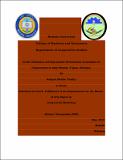| dc.contributor.author | Asqual, Berhe Tesfay | |
| dc.date.accessioned | 2014-09-29T14:12:50Z | |
| dc.date.available | 2014-09-29T14:12:50Z | |
| dc.date.issued | 2010-05 | |
| dc.identifier.citation | Asqual Berhe Tesfay (2010) Credit utilization and Repayment performance of members of cooperatives in Emba Alaje Woreda, Tigray, Ethiopia, Thesis. Mekelle:MU. | en_GB |
| dc.identifier.uri | https://opendocs.ids.ac.uk/opendocs/handle/20.500.12413/4535 | |
| dc.description.abstract | Delivering productive credit to the rural poor has been a hotly pursued but problem-plagued
undertaking. Providing low-cost, efficient credit services and recovering a high percentage of
loans granted are the ideal aims in rural finance. This is because low repayment performance
discourages the lender to promote and extend credit. Then investigation of the various aspects of
credit used and loan defaults is of great importance both for policy makers and the lending
institutions. Therefore, the major concern of this study was to identify the major socio-economic
and institutional factors that affect credit utilization and repayment capacity of members of
cooperatives of Emba Alaje Woreda in southern Zone of Tigray National State In the course of
this study, primary data were collected from156 sample households and secondary data also
collected from respective organizations in the study area. The analysis was made using
descriptive statistics and logit model. Descriptive statistics such as mean, standard deviation and
percentage were used for analyzing the data. In addition, t-test and chi-square test were
employed to compare credit use and misuse by borrowers as well as non defaulter and defaulter
groups with respect to the hypothesized and other related variables. Logit model was used to
identify the factors influencing credit utilization and repayment performance of households. Eight
continues explanatory variables and fourteen dummy variables were included in the logit mode.
Results of Variance Inflation Factor (VIF) and contingency coefficient showed that the
continuous and dummy variables have not multi-co linearity effect between the independent
variables and high degree of associated. The binary logit model for credit utilization and
repayment the most influential explanatory variables are 13 and14 respectively. Out of which,
five variables were significant and the rest were insignificant to explain the dependent variable.
The loan repayment model out put variables are supervision and misuse of the loan is highly
significant at less than 1 percent and loan from other sources and natural hazard are significant
at less than 10 per cent. On the other hand Credit utilization model out put affect by only one
variable which is timely credit service significant at less than 10 percent. Based on the findings
also included conclusions and recommendation. Therefore, taking this into consideration, these
factors as indicator for designing agricultural activity programs may assist cooperatives and
policy makers to introduce strategy for alleviating the serious problem and strengthening credit
utilization and repayment performance of farmers. | en_GB |
| dc.language.iso | en | en_GB |
| dc.publisher | Mekelle University | en_GB |
| dc.rights.uri | http://creativecommons.org/licenses/by-nc-nd/3.0/ | en_GB |
| dc.subject | Rural Development | en_GB |
| dc.title | Credit utilization and Repayment performance of members of cooperatives in Emba Alaje Woreda, Tigray, Ethiopia | en_GB |
| dc.type | Thesis | en_GB |
| dc.rights.holder | Mekelle University | en_GB |


